
Why Do Yachts Have Black Sails? [The Reason Explained]
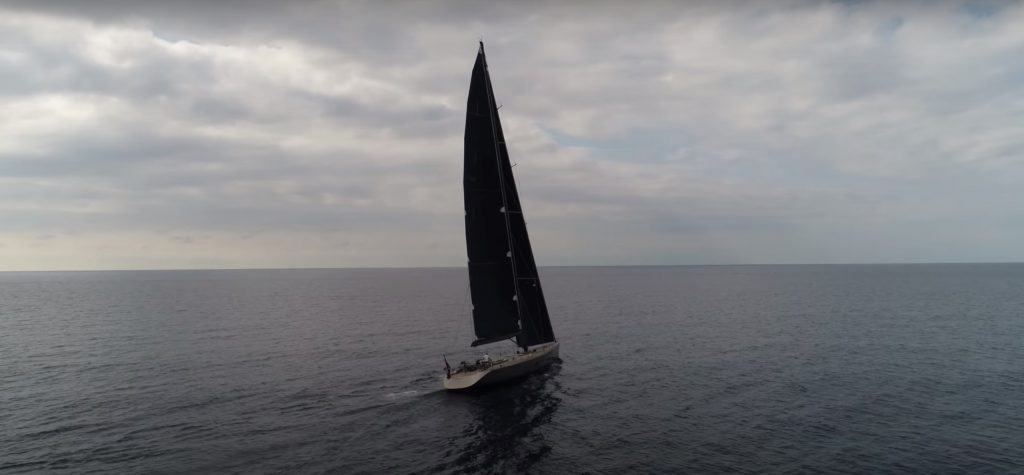
One of the joys of owning a yacht is that you get to customize that baby like nobody’s business. That’s why no two yachts ever look the same, even if they’re exactly the same make and model. From the upholstery, to the console, the decking, and of course the body paint, you can do pretty much anything you want with a yacht. Oh, except for the sails.
If you’ve been hanging around yachts enough, you might have noticed that all of them have black sails. What gives? Is this some unspoken yacht owner pact? Or is it all just a grand coincidence? Why do yachts have black sails? Here’s what you need to know.
Why Do Yachts Have Black Sails?
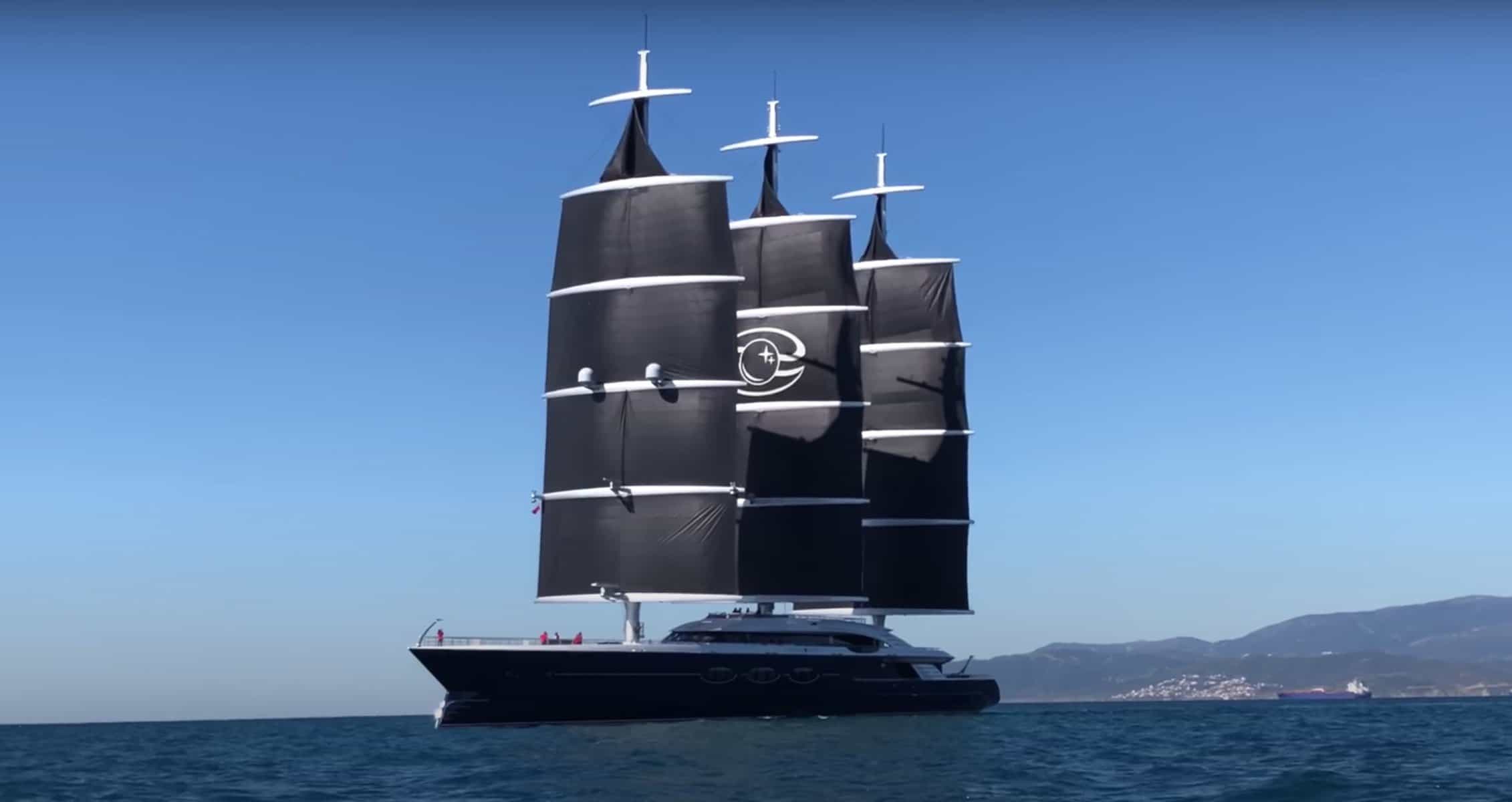
Unbeknownst to most people, yacht sails actually have a long history of design changes and modifications. Way back when, sails were made from cotton and came in a variety of colors, but often just a basic beige.
As time went on and manufacturers discovered better ways to make sails more efficient, they tossed out the cotton in favor of Kevlar. This material had Kevlar lines woven right into them which gave the sails better strength against strong winds. This also gave the sails a yellow tinge.
Fast forward a few years, and carbon fiber became the standard for yacht sails. They provided excellent resilience, UV resistance, and just the right flexibility to accommodate changes in wind strength and speed. And while they can come in different colors, most manufacturers offer them in plain black since they’re easier to manufacture that way.
Well, that covers pretty much the basics. But if you really want to get into it, then here are some of the most common reasons why yachts have black sails:
It’s What’s Available
Manufacturers for yacht sails compete closely with one another. So whatever sails one of them offers will be the same sails that others do. And since carbon fiber sails are pretty much the standard these days, that’s what all of them have in stock.
Keep in mind that they don’t really choose to make them black. It’s just that the material is naturally black because of the carbon. These fibers are weaved into the material which is basically layers of polyester that are naturally transparent.
Can they make them in other colors? Probably. But since black has become the standard, it seems they’re not really keen on mixing up the look. What’s more, making an effort to change the colors might mean having to add other materials into the mix, changing the way the sail performs all together.
It’s the Standard
The black color has become strongly associated with performance sails. It’s kind of like the marker of a quality sail. Yacht owners and even regular boat enthusiasts know that a black sail is the standard of top performance because it’s made from premium materials.
That said, changing the color might distance the product from that image. And since manufacturers don’t want to dissociate from being ‘top quality’ brands, there’s really no reason to try to change things up by offering other sail colors that might not be recognized as top tier.
It’s Sleek and Aesthetically Pleasing
Let’s be honest -- a black sail definitely adds a sporty look to a yacht. These high performance sails are intended to make your yacht operate optimally even in the face of strong winds and waves. And to match this competitive performance, they offer a distinct, athletic look.
No doubt, going for a spin in a yacht with black sails can make your vessel look like a true-blue, competition worthy boat. In fact, most boats that use these black carbon fiber sails actually compete in various water sports and racing events, which has associated the black color with supreme performance.
It’s a Mark of Quality
If you’re familiar with black sails for yachts, then you know from just a glance that these dark sails are the mark of quality. Actually anyone who wants to get a quality sail for their yacht will likely go for the black ones first since they’re developed for optimal performance in various wind conditions.
In essence, a black sail is like a seal of quality and durability. So if you want to showcase your yacht and demonstrate your superiority without having to say a word, all you really need is a black sail.
Are There Other Colors for Yacht Sails?
Absolutely -- sails still come in a variety of colors. In fact, you can get them in virtually any color you want. The trade-off though is that you probably won’t find carbon fiber sails in any other color but a dark gray or black. But that’s okay especially if you’re not really interested in using your boat competitively.
Unless you’re into competitive sailing or racing, you probably won’t need a carbon fiber sail. There are lots of other sails on the market that use various other materials, like Dacron sails which are still in use today. These were popular before Kevlar, but still find their place on the market because of their so-so performance and affordable prices.
Keep in mind though that when you buy a sail just to change up the color, you also sacrifice the durability and performance of the sail. As of writing, there is no other type of material that matches the level of performance, resilience, and quality of carbon fiber sails . So naturally, sails that come in other colors (and thus use different materials) will likely produce substandard performance.
Once You Go Black
So, why do yachts have black sails? It’s really a matter of material. Carbon fiber sails are all the rage these days for boat owners who want to get the best performance out of their yacht. But that doesn’t mean you can’t get a sail in a different color. There are lots of sails available on the market -- many of them offered in a variety of hues. Just remember that if they’re not carbon-fiber, they may not be as reliable as performance grade sails.
Related Posts
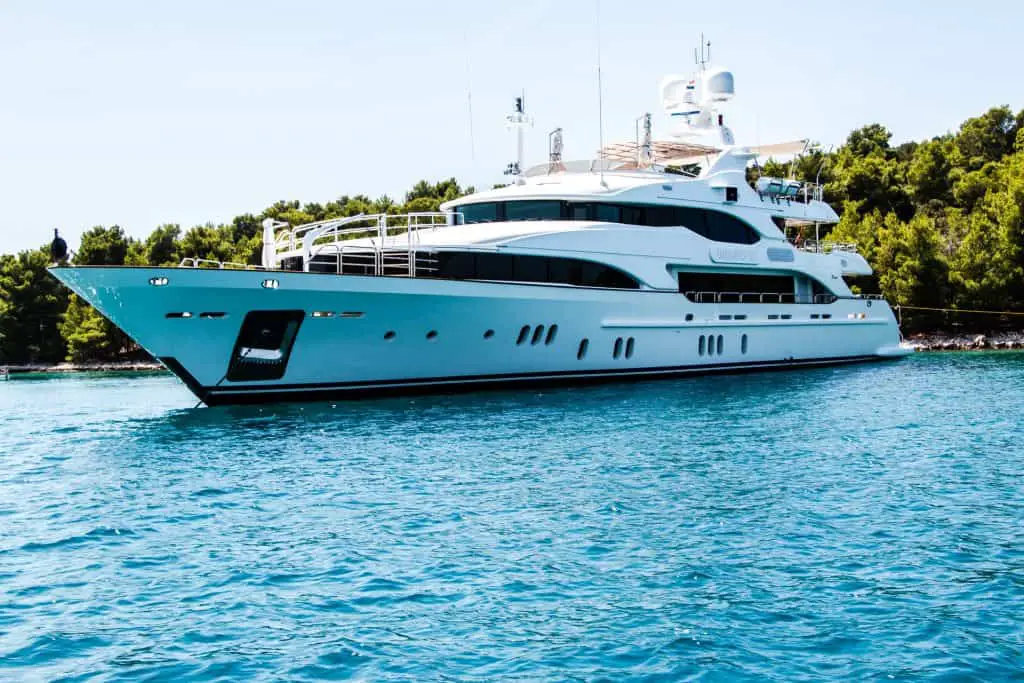
Yacht Broker Salary: How Much Does a Yacht Broker Make?

Why are Superyachts So Expensive? [The Costs Explained]

Fishing From a Yacht: Secrets of Sailboat Fishing
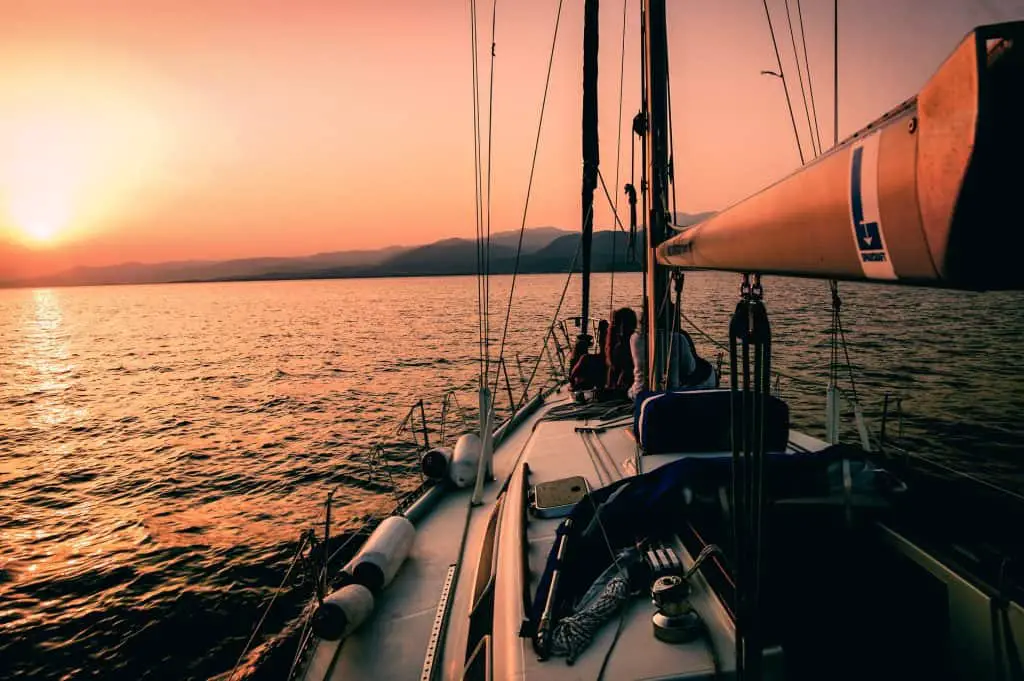
How to Sail from California to Hawaii (San Fran, LA, +)

The Worldwide Leader in Sailmaking
- Sail Care & Repair
- Sailing Gear
- Sail Finder
- Custom Sails
- One Design Sails
- Flying Sails
- New Sail Quote
- 3Di Technology
- Helix Technology
- Sail Design
- NPL RENEW Sustainable Sailcloth
- Sailcloth & Material Guide
- Polo Shirts
- Sweaters & Cardigans
- Sweatshirts & Hoodies
- Accessories
- Mid & Baselayers
- Deckwear & Footwear
- Luggage & Accessories
- Spring Summer '24
- Sailor Jackets
- Maserati X North Sails
- NS x Slowear
- Sailor Jacket
- Sustainability
- North Sails Blog
- Sail Like A Girl
- Our Locations
- Icon Sailor Jacket
- North SUP Boards
- North Foils
- North Kiteboarding
- North Windsurfing
SAIL FINDER
SAILING GEAR
COLLECTIONS & COLLAB
COLLECTIONS
WE ARE NORTH SAILS
ACTION SPORTS
Popular Search Terms
Collections
Sorry, no results for ""
WHY ARE RACING SAILS BLACK?
North sails expert per andersson explores fashion and function in the striking look of black sails on the water, and explains why sails may come in different shades of black..

Fashion, Function, and Material Composition
Black has not always been the fast look for sails, but lately more and more black sails are showing up on the water. Why? The simple answer is that many sails are now made with carbon fibers—the strongest load-carrying material in sails—and carbon is black. If some sails seem even blacker to you than they did a few years ago, you may be noticing North’s 3Di sails, a product that has gained significant market share since it first was introduced. Many sailmakers use carbon in their sails, but typically the carbon is laminated between layers of polyester or Mylar film, so it does not look completely black.
North’s 3DL sails fell into this category for many years, with variable densities of the carbon, depending on where it was needed to resist the heaviest loads. 3Di sails are darker because starting in 2013 with the introduction of 3Di RAW , we’ve rid our highest-performing sails of the cover layer and its associated parasitic weight.
We should point out that not all 3Di sails are black, because North has 3Di products that include aramid fibers, which are yellow, and Dyneema fibers, which are white. We also use black, white or gray taffeta or non-woven surface materials for durability on our 3Di ENDURANCE and 3Di OCEAN performance cruising products, for which the owner can choose the color of preference.

Early on, to make a more consistent and solid look on our RAW product, we began to pigment the aramid fibers because they simply looked better black, mixed with carbon and Dyneema fibers. “Dyneema fibers are not available with black pigment but with only a small amount of Dyneema in our 3Di sail structure, a small amount of pigment in the adhesive produces a solid black surface.”
Many sailmakers have followed the trend toward black sails. Most add a “light skin” or taffeta on top of the film to achieve the black look! Others simply add a non-woven layer of colored polyester material to make the sails black.

FEATURED STORIES
How to care for your foul weather gear, npl renew faq, flying sails 101.
- Refresh page

Why Do Yachts Have Black Sails? (Revealing the Reasons)
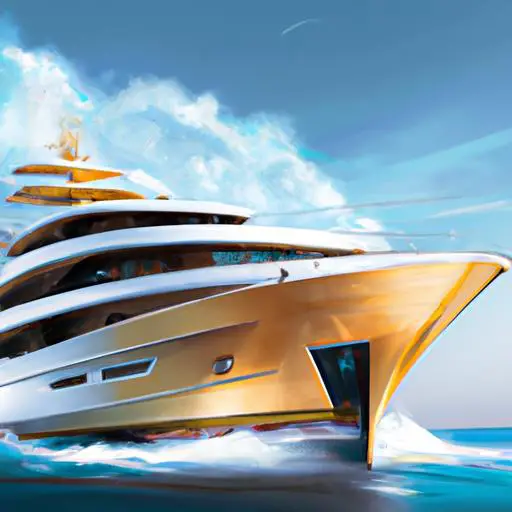
Yachts are known for their sleek designs and luxurious amenities, so it’s no surprise that they often have black sails.
But why is this? What are the advantages of having black sails on a yacht? In this article, we’ll explore the reasons why yachts have black sails, revealing the style factor, sun absorption benefits, cooling effects, glare reduction, low profile advantages, and performance impacts.
We’ll also discuss the different types of black sails available.
Get ready to discover the secrets behind the black sails of yachts!.
Table of Contents
Short Answer
Black sails are popular on yachts for a few reasons.
They help reduce glare from the sun, which can be a hazard when sailing.
Black sails also have a sleek and stylish look, which many yacht owners desire.
Finally, they provide a uniform look when a fleet of yachts is sailing together.
The Style Factor of Black Sails
When it comes to style, black sails are an extremely popular choice for yachts.
Not only do they create a sleek and sophisticated look, but they can also make a yacht stand out from the crowd.
The color black is also associated with luxury, power, and strength, three qualities that are often sought after in a yacht.
Black sails can also help a boat stand out against the horizon, making it easier to spot in crowded waters.
In addition, the dark color of the sails helps to create a strong contrast against the bright blue sea, further highlighting the yachts unique style and grace.
The Sun Absorption Benefits of Black Sails

When it comes to sailing, having the right equipment is essential.
Yachts often feature black sails as a stylish addition that adds a sleek and sophisticated look as well as some practical benefits.
Black sails are popular because they absorb heat from the sun, making it easier to move the boat through the water.
Additionally, the dark color helps to reduce the amount of sun that reaches the deck, keeping the boat and its occupants cool.
The black color also helps to reduce the amount of glare coming off of the sails, making it easier for the crew to navigate and sail the yacht.
The heat absorption benefits of black sails are especially valuable in warmer climates.
The sails act as a kind of sunshade, helping to reduce the amount of sunlight that reaches the deck and the passengers.
This helps to keep the boat and its occupants cool, allowing them to enjoy a comfortable sailing experience.
The dark color also helps to reduce the amount of glare coming off the sails, making it easier for the crew to keep track of their direction and speed.
The combination of these benefits makes black sails an ideal option for sailing yachts .
Not only do they provide a stylish and sophisticated look, but they also help to reduce the amount of sunlight that reaches the deck and the passengers, making for a more comfortable sailing experience.
They also help to reduce the amount of glare coming off the sails, making navigation easier for the crew.
All in all, black sails are a great choice for any yacht, offering style and practicality.
The Cooling of the Boat and Crew
The heat of the sun can make sailing a yacht quite uncomfortable and even dangerous in some cases.
This is why many yacht owners and sailors opt for black sails.
Of all the colors, black absorbs the most heat from the sun and helps keep the boat and its occupants cool.
Additionally, the black color helps to reduce the amount of sun that reaches the deck, further helping to keep the boat and its occupants cool.
Black sails are designed with a special material that is lightweight and breathable, allowing air to pass through while also absorbing the heat from the sun.
This breathability helps to keep the sails from becoming too hot and makes them comfortable to touch.
Additionally, the black color helps to reduce glare that can make it difficult to see and navigate the yacht.
This makes it easier for the crew to navigate and sail the yacht without any distractions or discomfort.
Overall, black sails are an ideal choice for yacht owners looking for a stylish and practical addition to their vessel.
The black color helps to absorb heat from the sun, keeping the boat and its occupants cool and comfortable.
Additionally, the black color helps to reduce the amount of sun that reaches the deck, and the special material used in the sails helps to reduce glare, making it easier for the crew to navigate and sail the yacht.
Reducing Glare from the Sails

Yachts are often equipped with black sails to reduce the amount of glare coming off of them.
The color black absorbs more light than other colors, making it easier for the crew to navigate and sail the yacht without being dazzled by the sun reflecting off of the sails.
The reduced glare also helps to keep the yacht and its occupants cooler, as less of the suns rays will reach the deck.
Additionally, the black color helps to make the yacht look more sophisticated and stylish, giving it a sleek and modern feel.
The black sails on a yacht also offer a few other advantages.
For one, the black sails absorb more heat from the sun, which can help to make the yacht easier to sail.
This is especially helpful in areas with high winds, as the heat from the sails can help to propel the yacht forward.
Additionally, the black sails are less likely to fade over time, meaning that they will keep their color and appearance for longer than sails in other colors.
Finally, black sails are also less likely to attract birds and other wildlife, which can be a nuisance if they land on the sails.
The Advantages of a Low Profile
Yachts featuring black sails can provide a distinct, sophisticated look that can make any vessel stand out from the crowd.
But black sails can also be advantageous for a number of reasons.
One of the most important advantages of having black sails is the reduced profile they provide.
Black sails absorb heat from the sun, which makes the boat easier to move through the water.
Additionally, the black color helps to reduce the amount of sun that reaches the deck, which can help keep the boat and its occupants cool.
Finally, the black sails are designed to reduce the amount of glare that comes off of the sails, making it easier for the crew to navigate and sail the yacht.
The low profile offered by black sails also makes them ideal for sailing in areas with a lot of wind and other weather-related challenges.
This is because the black sails are less likely to catch the wind and create unwanted resistance, allowing the yacht to move more smoothly and efficiently.
Additionally, the low profile of the sails can help to reduce the amount of drag the yacht experiences in the water, further improving the yachts speed and efficiency.
Finally, the low profile offered by black sails also makes them ideal for sailing in areas with a lot of people.
This is because the black sails can help to blend in with the environment, making the yacht less visible to other boats and people on the water.
The lower profile also helps to reduce the amount of glare coming off of the sails, making it easier for the crew to navigate and sail the yacht.
The Impact of Black Sails on Performance

When it comes to sailing, performance is key.
Yachts are built for speed and agility, and the choice of sail color can have a huge impact on their performance.
Black sails absorb more heat from the sun, helping to move the boat through the water faster.
They also reduce the amount of sun that reaches the deck, keeping the boat and its occupants cooler.
Additionally, black sails reduce the amount of glare coming off of the sails, making it easier for the crew to navigate and sail the yacht.
The black color of the sail also has a psychological impact on the crew.
Black sails look sleek and sophisticated, and can give the crew a feeling of confidence and power.
This can help to boost morale and performance, leading to better sailing results.
The black sails also have a practical purpose.
The dark color helps to hide dirt, salt and other stains that can accumulate on the sails over time.
This helps to keep the sails looking better for longer, and can help to maintain the yacht’s value.
By carefully considering the performance, psychological and practical benefits of black sails, it is easy to see why they are such a popular choice for yachts.
Black sails can help to improve the speed and performance of the yacht, boost the morale of the crew, and keep the sails looking better for longer.
The Different Types of Black Sails
When it comes to yachting, black sails are becoming increasingly popular.
Depending on the type of yacht, there are multiple varieties of black sails to choose from.
Some of the most common types are laminated sails, mylar sails, and dacron sails.
Laminated sails are made from multiple layers of fabric that have been bonded together with resin.
These sails are typically lightweight and provide excellent performance on the water.
They are also known for their strength, durability, and resistance to UV light.
Mylar sails are made from a synthetic material that is designed to be lightweight and durable.
These sails provide a sleek look and can withstand higher wind speeds than their laminated counterparts.
Dacron sails are made from a woven material that is extremely strong and durable.
This material is perfect for sailing in high winds, and it also helps to reduce the amount of glare that comes off the sails.
No matter which type of black sail you choose, they all offer the same benefits: they provide a stylish look, reduce the amount of sun that reaches the deck, and also reduce glare.
This makes them the perfect choice for sailing in any conditions.
Final Thoughts
The black sails on yachts offer a unique style factor and provide many practical benefits, such as absorbing heat from the sun, cooling the boat, reducing glare, and providing a low profile.
Understanding the advantages of black sails can help you choose the best type of sail for your yacht, and ultimately improve your performance on the water.
With this knowledge, you’ll be ready to sail with style and confidence!.
James Frami
At the age of 15, he and four other friends from his neighborhood constructed their first boat. He has been sailing for almost 30 years and has a wealth of knowledge that he wants to share with others.
Recent Posts
Does Your Boat License Expire? Here's What You Need to Know
Are you a boat owner looking to stay up-to-date on your license requirements? If so, youve come to the right place! In this article, well cover everything you need to know about boat license...
How to Put Skins on Your Boat in Sea of Thieves? (Complete Guide)
There is a unique sense of pride and accomplishment when you show off a boat you customized to your exact specifications. With Sea of Thieves, you can customize your boat to make it look like your...

Why Racing Sailing Yachts Opt for Black Sails: An Insider’s Guide
Racing sailing yachts are often seen with black sails, which can be a striking and intimidating sight for onlookers. But why do these boats use black sails, and what advantages do they offer?
One reason for the use of black sails is to reduce glare and improve visibility for the crew. White sails can reflect sunlight and create a glare that makes it difficult to see the course ahead, especially in bright conditions. Black sails absorb light and reduce glare, making it easier for sailors to spot obstacles and make quick decisions.
Another advantage of black sails is their ability to absorb heat and transfer it to the sailcloth, which can help to create more lift and speed. This is particularly useful in light wind conditions, where the extra boost can make a significant difference. Additionally, black sails can be made from materials that are more durable and resistant to UV damage, which can extend their lifespan and reduce maintenance costs.
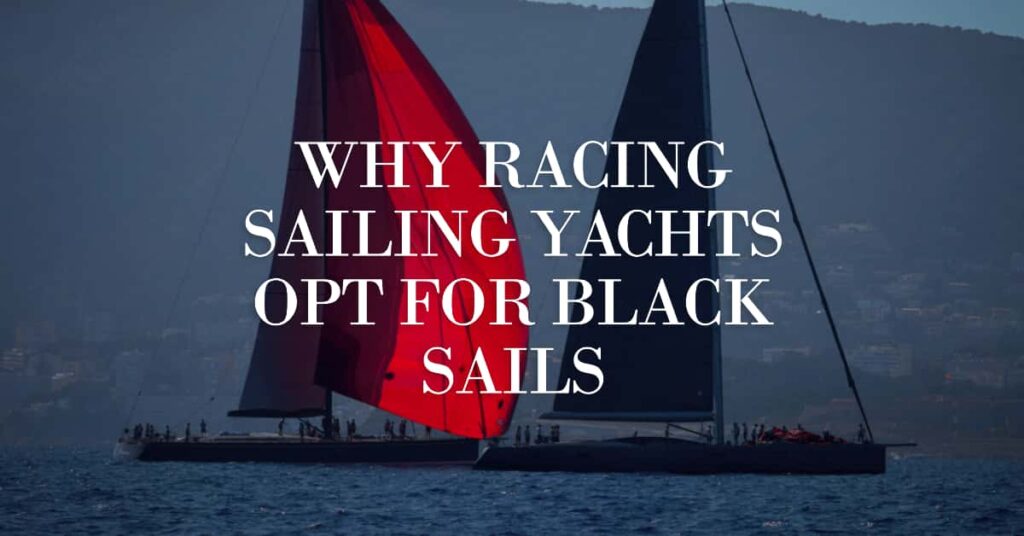
Advantages of Black Sails
Black sails have become a popular choice for racing sailing yachts due to the following advantages:
Black sails give a sleek and modern look to the yacht, which is visually appealing and can attract sponsors and fans. The sails also look good in photographs and videos, which is important for marketing purposes.
Higher Speeds
Black sails absorb more sunlight than white sails, which makes them warmer and increases their efficiency. This can result in higher speeds, especially in light winds. The difference in speed may not be significant, but it can make a difference in a race where every second counts.
UV Protection
Black sails are less likely to fade or get damaged by UV rays than white sails. This is because black sails absorb more light and heat than white sails, which can cause them to break down faster. Black sails made of carbon fibers are especially resistant to UV damage and can last longer than other materials.
Durability and Strength
Black sails are made of strong and durable materials, such as carbon fibers, which can withstand high winds and rough seas. They are also less likely to get dirty or stained than white sails, which can be a problem in long races.
Black sails are usually lighter than white sails, which can make a difference in racing. The weight savings can be used to add other equipment or to improve the yacht’s performance.
Black sails absorb more heat than white sails, which can be a disadvantage in hot weather. The heat can make the yacht’s cabin uncomfortable and can affect the crew’s performance. However, this can be mitigated by using lighter materials or by adding ventilation.
In conclusion, black sails have several advantages over white sails, including a sleek look, higher speeds, UV protection, durability and strength, and weight savings. However, they may not be suitable for all conditions, especially in hot weather.
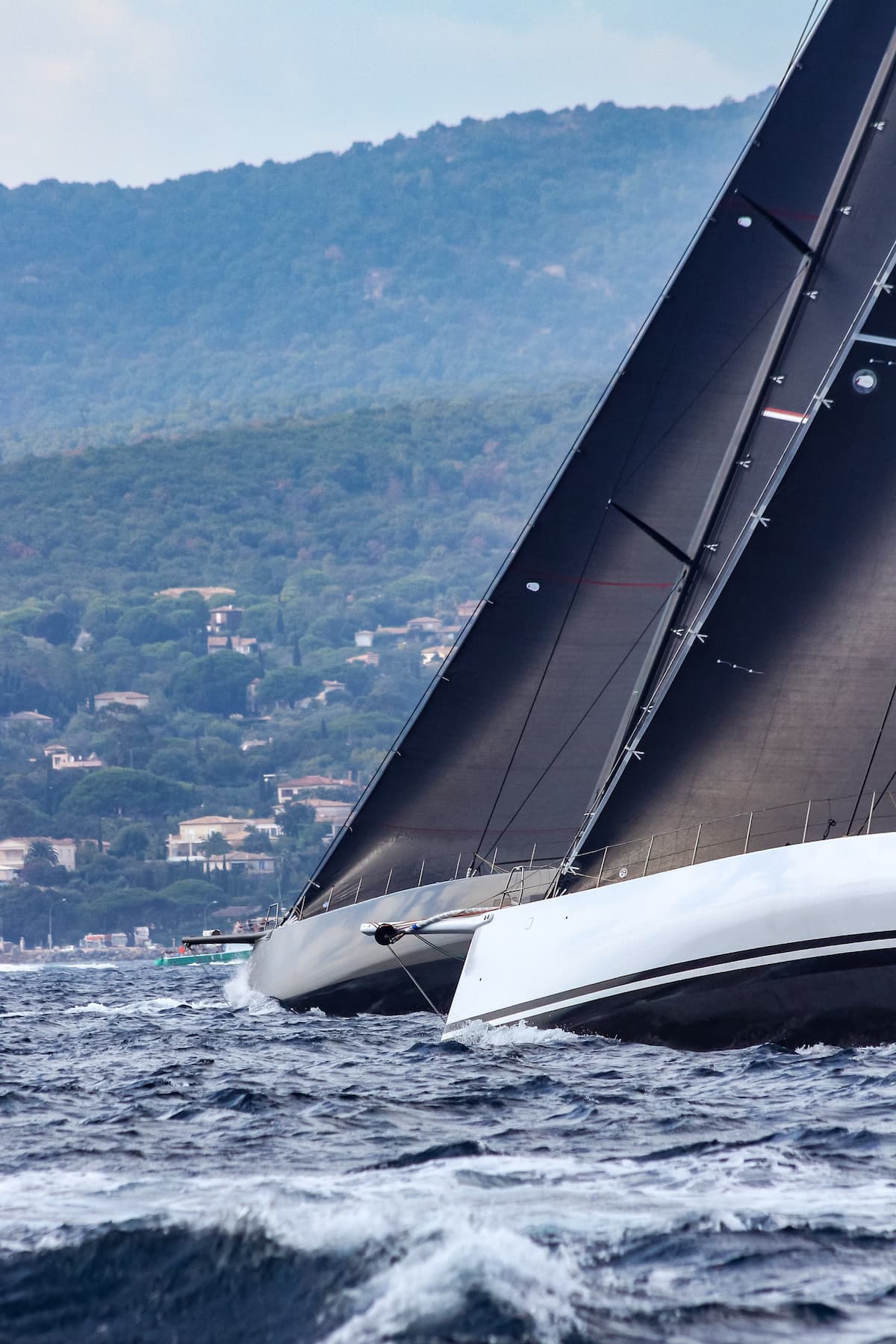
Disadvantages of Black Sails
Black sails may look sleek and stylish, but they do come with some disadvantages that sailors should consider before choosing them for their racing yachts.
One of the main disadvantages of black sails is their cost. They are often more expensive than traditional white sails, as they require special materials and manufacturing processes. This can be a significant investment for sailors, and may not be worth it for those on a tight budget.
Maintenance
Black sails also require more maintenance than white sails. They tend to show dirt and stains more easily, which means they need to be cleaned more frequently. Additionally, black sails can be prone to fading over time, which means they may need to be replaced more frequently than white sails.
Delamination
Another potential issue with black sails is delamination. This occurs when the layers of the sail start to separate, which can weaken the sail and make it less effective. Black sails are more prone to delamination than white sails, which means sailors need to be vigilant about checking for signs of damage.
Black sails are also more susceptible to damage from UV rays. The dark color absorbs more sunlight, which can cause the material to break down more quickly. Sailors need to be careful to store their black sails properly and to protect them from the sun when not in use.
Finally, black sails can be less visible than white sails, especially in low light conditions. This can make it more difficult for other boats and ships to see the racing yacht, which could be dangerous. Sailors need to take extra precautions to ensure their boat is visible to other vessels on the water.
Overall, while black sails may look impressive, they do come with some drawbacks that sailors need to consider before choosing them for their racing yachts.
Material Composition of Black Sails
Black sails are a common sight in racing sailing yachts. They are often made of a combination of materials that provide the necessary strength and durability for the high-performance demands of racing. Here are some of the materials that are commonly used in the composition of black sails:
- Carbon fibers : Carbon fibers are known for their strength and lightness. They are often used in the construction of high-performance sails, including black sails.
- Polyester : Polyester is a common material used in sail construction. It is known for its durability and resistance to UV rays.
- Kevlar : Kevlar is a type of aramid fiber that is known for its strength and resistance to abrasion. It is often used in the construction of racing sails, including black sails.
- Dyneema fibers : Dyneema fibers are also known for their strength and lightness. They are often used in the construction of high-performance sails.
- Taffeta : Taffeta is a type of non-woven surface material that is often used in sail construction. It provides a smooth surface that reduces drag and improves performance.
In addition to these materials, black sails often have an adhesive layer that helps to bond the various layers of material together. This adhesive layer is essential for providing the necessary strength and durability for racing sails.
Overall, the material composition of black sails is carefully chosen to provide the necessary strength, durability, and performance for racing sailing yachts.
Types of Black Sails
There are several types of black sails used in racing sailing yachts. Each type is designed to provide specific benefits to the yacht and its crew. In this section, we will discuss some of the most popular types of black sails.
3Di sails are a type of black sail that is known for its durability, lightweight, and high-performance racing capabilities. These sails are made using helix load shearing technology, which allows them to withstand heavy loads and maintain their shape even in strong winds.
There are two main types of 3Di sails: 3Di Ocean and 3Di Endurance. 3Di Ocean sails are designed for offshore racing and cruising, while 3Di Endurance sails are designed for long-distance racing. Both types of sails are made using the same technology and materials, but they are optimized for different sailing conditions.
One of the key benefits of 3Di sails is their ability to maintain their shape over time. Unlike traditional sails, which can stretch and deform over time, 3Di sails are designed to maintain their shape even after extended use. This means that they provide consistent performance throughout their lifespan.
In addition to their performance benefits, 3Di sails are also environmentally friendly. They are made using recyclable materials and are designed to last longer than traditional sails, which reduces the environmental impact of sail production.
Overall, 3Di sails are a popular choice for racing sailing yachts due to their durability, lightweight, and high-performance capabilities. Whether racing offshore or long-distance, these sails are designed to provide consistent performance and withstand the rigors of racing.
Other Sail Colors
While black sails are commonly used in racing sailing yachts, other sail colors can also be used depending on the purpose and preference of the sailor. Here are some of the other sail colors that are used in sailing:
White Sails
White sails are the most common type of sails used in sailing. They are versatile and can be used in different weather conditions. They are also easy to maintain and repair. White sails are often used in cruising and recreational sailing.
Red sails are not commonly used in sailing, but they can be used for racing or for aesthetic purposes. They are not as versatile as white sails and are best used in specific weather conditions.
Tanbark Sails
Tanbark sails are made from a type of dyed canvas that gives them a reddish-brown color. They are often used in traditional and classic sailing yachts for aesthetic purposes. Tanbark sails are not as durable as modern sails and require more maintenance.
Grey sails are not commonly used in sailing, but they can be used for racing or for aesthetic purposes. They are not as versatile as white sails and are best used in specific weather conditions.
Sail colors can also be influenced by fashion and image. Pirate ships, for example, are often depicted with black sails to create a menacing image. In modern sailing, the choice of sail color can also be influenced by fashion and personal preference.
In conclusion, while black sails are commonly used in racing sailing yachts, there are other sail colors that can be used depending on the purpose and preference of the sailor. White sails are the most common type of sails used in sailing, while red sails, tanbark sails, and grey sails are used for specific purposes. The choice of sail color can also be influenced by fashion and image.
Yacht Racing and Black Sails
Yacht racing is a highly competitive sport that requires the best performance from the boats and the sailors. Many factors can affect the performance of a yacht, including the design, materials , and modifications. One of the most visible modifications that yacht racers use is black sails.
Black sails are not a new concept in yacht racing. They have been used for many years by some of the most successful yacht racers in the world. The reason for this is simple: black sails offer better performance than traditional white sails.
Black sails are made from a different material than white sails. They are made from a high-tech material that is lighter, stronger, and more durable than traditional sailcloth. This material is also more resistant to UV rays, which can cause white sails to degrade over time.
In addition to the material, black sails are also designed differently than white sails. They are cut differently, with a flatter shape that allows them to generate more lift. This increased lift translates into better performance, especially in light wind conditions.
Yacht racers also use black sails because they are more visible on the water. This is especially important in crowded racing conditions, where it can be difficult to see other boats. Black sails stand out against the water and make it easier for sailors to avoid collisions.
Finally, black sails are also easier to maintain than white sails. They do not show dirt or stains as easily, and they do not need to be washed as often. This makes them a popular choice for yacht racers who want to spend more time on the water and less time maintaining their sails.
In conclusion, black sails are a popular choice for yacht racers who want to improve their performance on the water. They offer better lift, increased visibility, and easier maintenance than traditional white sails. While they may not be the right choice for every sailor, they are certainly worth considering for those who want to compete at the highest level of yacht racing.
In conclusion, the use of black sails in racing sailing yachts is not just a fashion statement but has a practical purpose. The black color absorbs more heat than any other color, which helps to warm up the air inside the sail, making it more efficient. The use of black sails is most effective in colder climates where the air is denser and less efficient at powering the sail.
Additionally, black sails are more durable and resistant to UV rays, which can cause damage to the sail over time. This makes black sails a practical choice for racing yachts that are exposed to the sun and wind for extended periods.
However, it is important to note that the use of black sails is not always the best choice. In warmer climates, the heat absorbed by the black sail can cause the air inside to expand, reducing the sail’s efficiency. In these conditions, lighter-colored sails may be more effective.
Overall, the use of black sails in racing sailing yachts is a strategic decision based on the specific conditions of the race and the preferences of the sailors. It is just one of many factors that contribute to the overall performance of the boat and should be carefully considered before making a decision.
About the author
I worked as an officer in the deck department on various types of vessels, including oil and chemical tankers, LPG carriers, and even reefer and TSHD in the early years. Currently employed as Marine Surveyor carrying cargo, draft, bunker, and warranty survey.
Leave a Reply Cancel reply
Your email address will not be published. Required fields are marked *
Save my name, email, and website in this browser for the next time I comment.
Latest posts

Fiberglass vs. Steel: Which Is More Reliable?
Shipping professionals should get the most from their investment, so which is more reliable: steel vs. fiberglass? Here’s how to determine the better option.

What Does a Longshoreman Do?
Longshoremen play a critical role in the global supply chain, bringing billions worth of cargo into the country. So what does a longshoreman do exactly?

The Ocean Warming Effects on Marine Life
The last few decades have seen ocean temperatures rise as climate change begins to affect maritime industries worldwide. Here are the ocean warming effects on marine life seen so far.
No products in the cart.
Sailing Ellidah is supported by our readers. Buying through our links may earn us an affiliate commission at no extra cost to you.
The Reason Behind Different Sail Colors
The color of a sail is normally the result of the type of fiber used in the manufacturing process. Some types of sailcloth can also be colored or painted to achieve the desired appearance.
Sails have been a normal sight since the early days of sailing ships cruising the seven seas. It was common to see red sails on the old Viking ships and the Chinese Junk rigs, but white or yellow sails were the most dominant color back then.
Nowadays, we mostly see white sails around us, except for those on racing boats. But other colors are becoming more apparent as previously exotic materials have become more available to everyone.
To truly understand the reason behind the different sail colors, we need to go back through history to learn how it has impacted our modern trends.
Historical sailcloth and how it was colored
There was a reason for the colorful sails back in the old days. While the Vikings wove and colored their sails from wool until the 14th century, Linen eventually became the preferred material in the Western world.
Linen was used until the 19th century but was a heavy fabric to use as sails grew. They started implementing cotton, which later became more popular since it made the sails lighter. However, it didn’t replace Linen because of its higher strength, and the two fabrics were continuously used for different purposes.
Wool, Linen, and Cotton were often sealed with a composition of tar for protection, which often resulted in sails appearing yellow or brown. Ochre or silk was sometimes added to the mix to color the sails differently.
In the late 20th century, synthetic fibers were introduced and have since been used up until now. Polyester woven fabric, or Dacron as trademarked by DuPont, was introduced in the 1950s and was far superior to Linen and Cotton. As a result, it was pretty much the only reliable fabric used in sails up until around 1980.
The history of laminate sails and their colors
An inventor, textile engineer, and local sailing legend called Russ was playing around with Mylar panels sometime back in the 1940s and 50s. He made a template of wood with the shape of a mainsail and glued together the Mylar panels to form a sail for his dinghy.
The prototype worked well, showed no signs of stretch under sail, and kept its shape perfectly. It did have a big drawback, though. Since Mylar is transparent, Russ suffers from the glaring sun magnified through the sail, and he can only endure it for short moments at a time.
Little did he know that he might be the founding father of what later became sailing laminates. Later on, others took over his work and eventually managed to glue Dacron and Mylar together, making the first known laminate sail. In the 1977 America’s Cup, the racing team onboard Enterprise sported a Genoa reinforced by Mylar, making them the first racing boat using a laminate sail.
This was just the beginning of what eventually became the industry standard.
Back in the early 1970s, there was high demand for more stretch-resistant sail cloth, especially in the racing industry, and the companies in the business started experimenting with laminates.
Many attempts with various fibers failed in the beginning due to unreliability, but by the 1980s, the manufacturers were on track with their developments.
In 1992, again during America’s Cup, America3 was the first boat to fly North Sails’ 3DL laminate. It had taken them three years and $12 million to develop the technology which would later dominate sailboat racing. The original sails were almost transparent like Russ’s sail, but North’s eventually changed the color to dark grey.
Ten years later, North introduced the 3Di sails in matt black, and most other manufacturers followed the trend.
Some related and frequently asked questions
Why are sails black.
Some laminate sails are black due to being manufactured with carbon fibers or black-pigmented aramid fibers. Others have a black taffeta to make the sail appear black.
Carbon is exceptionally strong and lightweight and gives the sail excellent performance. Since most racing boats these days have followed North Sails’ example with black sails, it has become a popular trend and a symbol of speed .
Carbon sails don’t have to be black, but they sure look awesome and trendy!
Why are sails yellow?
Laminate sails can appear yellow or golden when constructed with yellow aramid fibers such as Kevlar®, Twaron®, or Technora® with a light-colored taffeta on top.
Carbon fibered laminate sails have a high price tag, but there are many cruising laminates at a reasonable price, and they have become more regular in the leisure market in the last few years.
Why are sails white?
Today’s most commonly used sails are white because they are manufactured using a fabric called Dacron, made by spinning naturally white polyester fibers into a yarn and then woven into cloth.
Technology has advanced over the years, and many stronger woven fabrics are available today, like the Hydra Net weaved with Dyneema. However, Dacron sails are still the most popular choice today due to their extreme durability and relatively low price.
The benefits of white sails
- It is easier to see the telltales and shapes on a white sail at night.
- A powerful torch can light up a white sail like a giant lamp, making it easy for anyone nearby to see you in case you want to make yourself visible.
- White sails are cheaper to buy than colored sails. Some sailmakers can deliver sails in various colors, but they usually keep the stock in the fabric’s natural shade. Making a special order can get pricey.
- It looks great and traditional to fly bright white sails, just like the ships in the old days. Others might not agree, but I think a white sail carries some symbolism and can, in a way, honor our ancestors’ sailors.
The d rawbacks of white sails
- Dirt and mold show quickly and don’t look good. You should clean and service your sails, of course, but at some point, those stains will stick.
- Color degradation happens over time, and the sails will look yellowish with age. I can testify to discolored old sails as I recently replaced my Mainsail and Genoa and was almost blinded by how bright the new ones were.
- Bright white can get blinding in the sun. Wearing sunglasses makes a short process of the problem, though, and I think the benefits of a white sail outweigh the downsides.
Why are some sails colorful?
Light-wind sails, such as spinnakers, often get seen in many combinations of colors. These sails are usually made of nylon due to the fabric’s low weight and high tensile strength. Since nylon is easily dyed, you often get to choose from various patterns and colors when you order them.
My gennaker, a.k.a. “Big Red,” is…well, red. And it looks awesome!
Others even take it a step further and have their logo printed on the sail, which I think looks excellent. Seeing the big, colorful ballooners fly in front of the boat on a sweet downwind sail will probably bring out smiles in most of us.
How long do sails last?
Sails can last anything from 2-20 years, depending on the type of sail, sailcloth used, and how well it is cared for. Laminate sails usually have the shortest lifespan, while dacron and hybrid cloth last a good while longer.
How long your sail will last depends on what type of sail you choose. What type of sail you choose depends on what you want to use the sails for, and so on. I actually wrote an article about the expected lifespan of sails and included some ways to make them last longer!
The Expected Lifespan Of Sails And 8 Tips To Make Them Last Longer
Final words
Whether you prefer white, black, or colorful sails, you will find something that suits you. Maybe you are like me, who likes traditional white over trendy black, or perhaps you want to chip in a few extra bucks and get yourself sails in blue.
History has taught us a lot about sails. Not just in the sense of technology development but also in the way the most extreme sailors in the business have influenced the trends.
What type of sail do you prefer, and in what color? Leave your comment below !
Sources: Wikipedia , North Sails , Scuttlebutt , Afloat , Boat Design , itBoat
Sharing is caring!
Skipper, Electrician and ROV Pilot
Robin is the founder and owner of Sailing Ellidah and has been living on his sailboat since 2019. He is currently on a journey to sail around the world and is passionate about writing his story and helpful content to inspire others who share his interest in sailing.
Leave a Reply Cancel reply
Your email address will not be published. Required fields are marked *
Log in or sign up for Rotten Tomatoes
Trouble logging in?
By continuing, you agree to the Privacy Policy and the Terms and Policies , and to receive email from the Fandango Media Brands .
By creating an account, you agree to the Privacy Policy and the Terms and Policies , and to receive email from Rotten Tomatoes and to receive email from the Fandango Media Brands .
By creating an account, you agree to the Privacy Policy and the Terms and Policies , and to receive email from Rotten Tomatoes.
Email not verified
Let's keep in touch.

Sign up for the Rotten Tomatoes newsletter to get weekly updates on:
- Upcoming Movies and TV shows
- Trivia & Rotten Tomatoes Podcast
- Media News + More
By clicking "Sign Me Up," you are agreeing to receive occasional emails and communications from Fandango Media (Fandango, Vudu, and Rotten Tomatoes) and consenting to Fandango's Privacy Policy and Terms and Policies . Please allow 10 business days for your account to reflect your preferences.
OK, got it!
Movies / TV
No results found.
- What's the Tomatometer®?
- Login/signup
Movies in theaters
- Opening this week
- Top box office
- Coming soon to theaters
- Certified fresh movies
Movies at home
- Netflix streaming
- Prime Video
- Most popular streaming movies
- What to Watch New
Certified fresh picks
- Monkey Man Link to Monkey Man
- The First Omen Link to The First Omen
- The Beast Link to The Beast
New TV Tonight
- Chucky: Season 3
- Mr Bates vs The Post Office: Season 1
- Fallout: Season 1
- Franklin: Season 1
- Dora: Season 1
- Good Times: Season 1
- Beacon 23: Season 2
Most Popular TV on RT
- Ripley: Season 1
- 3 Body Problem: Season 1
- Sugar: Season 1
- Parasyte: The Grey: Season 1
- A Gentleman in Moscow: Season 1
- Shōgun: Season 1
- The Regime: Season 1
- We Were the Lucky Ones: Season 1
- The Gentlemen: Season 1
- Best TV Shows
- Most Popular TV
- TV & Streaming News
Certified fresh pick
- Ripley Link to Ripley
- All-Time Lists
- Binge Guide
- Comics on TV
- Five Favorite Films
- Video Interviews
- Weekend Box Office
- Weekly Ketchup
- What to Watch
Best Movies of 2024: Best New Movies to Watch Now
25 Most Popular TV Shows Right Now: What to Watch on Streaming
What to Watch: In Theaters and On Streaming
Awards Tour
CinemaCon 2024: Day 1 – WB Showcases Joker: Folie à Deux , Furiosa , and More
TV Premiere Dates 2024
- Trending on RT
- Play Movie Trivia
Black Sails
Where to watch.
Buy Black Sails on Vudu, Prime Video, Apple TV.
Cast & Crew
Robert Levine
Jonathan E. Steinberg
Toby Stephens
Captain Flint
Eleanor Guthrie
Luke Arnold
John Silver
Jessica Parker Kennedy

Popular TV on Streaming
Tv news & guides, this show is featured in the following articles., series info.

The global authority in superyachting
- NEWSLETTERS
- Yachts Home
- The Superyacht Directory
- Yacht Reports
- Brokerage News
- The largest yachts in the world
- The Register
- Yacht Advice
- Yacht Design
- 12m to 24m yachts
- Monaco Yacht Show
- Builder Directory
- Designer Directory
- Interior Design Directory
- Naval Architect Directory
- Yachts for sale home
- Motor yachts
- Sailing yachts
- Explorer yachts
- Classic yachts
- Sale Broker Directory
- Charter Home
- Yachts for Charter
- Charter Destinations
- Charter Broker Directory
- Destinations Home
- Mediterranean
- South Pacific
- Rest of the World
- Boat Life Home
- Owners' Experiences
- Interiors Suppliers
- Owners' Club
- Captains' Club
- BOAT Showcase
- Boat Presents
- Events Home
- World Superyacht Awards
- Superyacht Design Festival
- Design and Innovation Awards
- Young Designer of the Year Award
- Artistry and Craft Awards
- Explorer Yachts Summit
- Ocean Talks
- The Ocean Awards
- BOAT Connect
- Between the bays
- Golf Invitational
- Boat Pro Home
- Pricing Plan
- Superyacht Insight
- Product Features
- Premium Content
- Testimonials
- Global Order Book
- Tenders & Equipment
Top 10 largest sailing yachts in the world
The list of the top ten largest sailing yachts in the world is not easily disrupted. In fact, it had remained unchanged since the launch of the 106.7-metre Oceanco Black Pearl in 2018, which swiped the top spot from Lürssen 's 93-metre Eos . For four years, Black Pearl remained the largest yacht in the world until early in 2023 when Oceanco sent a new flagship down the slipway, the mighty 127-metre Koru . Read on to discover our official list of the largest sailing yachts in the world.
1. Koru | 127m
Leading this list is a new entry: Oceanco 's record-breaking 127-metre sailing yacht Koru . Commissioned by Amazon founder Jeff Bezos, Koru has been the subject of much speculation for years but was revealed in all its glory in 2021. Not only is she the largest sailing yacht in the world, she is also the largest superyacht ever to be built in the Netherlands. Her name, Koru, is the Māori word meaning "new beginnings" and she is accompanied by a 75-metre support vessel named Abeona . She was delivered in 2023 and is over 20 metres longer than the former title-holder Black Pearl.
- Builder: Oceanco
- Country of build: Netherlands
- Delivery year: 2023
- Length Overall: 125.82 m
- Beam: 16.95 m
- Gross Tonnage 3493 t
More about this yacht
More stories, 2. black pearl | 106.7m.
Instantly recognisable with her black sails and Dynarig set-up, Black Pearl is the second-largest sailing yacht in the world. Delivered during the same year as 142.81-metre Sailing Yacht A (officially designated as a sail-assisted motor yacht), Black Pearl spent five years in development at Dutch yard Oceanco . Dykstra Naval Architects , Ken Freivokh , Nuvolari Lenard , BMT Nigel Gee and Gerard P Villate all contributed their expertise to this monumental project, which looks set to turn heads the world over for decades to come. She is often compared to Maltese Falcon , the first Dynarig superyacht, but boasts a number of technological advancements. She flies 25 per cent more sail area with hinging spars that fold down to allow her to pass through the Panama Canal, but it is what lies beneath that really counts. Two variable pitch propellers harness kinetic energy while she is under sail, which can run the hotel or recharge the batteries, allowing her to cross oceans without expending a drop of fuel.
- Delivery year: 2018
- Length Overall: 106.7 m
- Gross Tonnage 2700 t
3. Eos | 92.93m
Eos was built in Germany under a cloak of secrecy for her American media and movie mogul Barry Diller. Eos is a three-masted Bermuda rigged schooner and was refitted at Royal Huisman in 2011. After emerging from her refit the yacht caught fire in Norway and had to return to the yard to be repaired.
- Builder: Lurssen
- Country of build: Germany
- Delivery year: 2006
- Length Overall: 92.93 m
- Beam: 13.5 m
- Gross Tonnage 1500 t
4. Athena | 90m
Athena was built by the Royal Huisman in Holland for US software developer Jim Clark. Athena's advanced engineering means that she is able to sail in relatively light airs, while still offering the interior space typically only found on motor yachts. In stronger winds, Athena has been credited as attaining 19 knots under sail. The yacht's three closed decks include a large owner's suite, four guest suites, a saloon and dining room on the main deck and a sky lounge on the upper deck. Her clipper-bow and three-masted schooner sprung from the boards of Pieter Beeldsnijder (exterior styling) and Dykstra Naval Architects (naval architecture).
- Builder: Royal Huisman
- Delivery year: 2004
- Length Overall: 90 m
- Beam: 12.2 m
- Gross Tonnage 1103 t
5. Maltese Falcon | 88m
Maltese Falcon was built for the late American venture capitalist Tom Perkins. The iconic three-masted schooner is the fifth-largest sailing yacht in the world. Maltese Falcon's rig is made up of three unstayed, 'weapons-grade' carbon fibre masts, with a fully computerised sail and rotating mast system. The system has been dubbed a triumph of design, development and engineering and Maltese Falcon has topped an impressive 24 knots under sail. The Ken Freivokh interior is a marriage of industrial chic and high tech. It features leather, glass, wood and steel as well as a modern art collection. The yacht has accommodation for 12 guests and is available for charter.
- Builder: Perini Navi
- Country of build: Turkey
- Length Overall: 88 m
- Beam: 12.47 m
- Gross Tonnage 1112 t
Yachts for charter
6. aquijo | 85.9m.
The highly anticipated Aquijo was the result of a collaboration between Vitters and Oceanco. Both Dutch yards worked closely with the owner's representative to create a highly complex, performance-driven sailing machine that became the third largest sailing superyacht when launched. Aquijo is an aluminium ketch-rigged yacht, and features a custom steering system. Aquijo's interior layout provides clear sight lines thanks to her high-volume superstructure.
- Builder: Vitters | Oceanco
- Delivery year: 2016
- Length Overall: 85.9 m
- Beam: 14.48 m
- Gross Tonnage 1538 t
7. Sea Eagle II | 81m
Delivered in 2020, Sea Eagle II is the most recent addition to the top ten largest sailing yachts in the world. Built by Royal Huisman, Sea Eagle II features exterior styling by Mark Whiteley and naval architecture penned by Dykstra Naval Architects . Sold in summer 2016 by Northrop & Johnson as Project RH400, Sea Eagle II is the largest yacht ever built by the Dutch yard.
- Delivery year: 2020
- Length Overall: 81 m
- Gross Tonnage 1150 t
8. M5 | 78.4m
Built by Vosper Thorneycroft in Southampton, England, M5 was launched as the iconic yacht Mirabella V in 2004. She remains the world’s largest sloop to date. M5 was designed by Ron Holland for American yachtsman Joe Vittoria, who enjoyed sailing her for seven years before she was sold on. The new owner renamed her M5 and she was extended by 3.2 metres in a refit at Pendennis before her relaunch in 2013. Her most recent refit , however, in 2019, saw M5 emerge from the sheds with all new paint-work, composite biminis, a reinforced mast and a new bow-thruster.
M5 has a displacement of 780 tonnes (165 tonnes of which is the keel). The carbon fibre mast is an amazing 88.3 metres tall and can carry approximately 3,700 square metres of sail.
- Builder: Vosper Thornycroft
- Country of build: United Kingdom
- Length Overall: 78.4 m
- Beam: 14.8 m
- Gross Tonnage 1009 t
9. Badis | 70m
The second largest Perini Navi sailing yacht to date, Badis was built for the multiple superyacht owner Bill Duker and launched in 2016 as Sybaris . The name comes from a Greek settlement in ancient Italy that was famed for its hedonism, feasts and excesses. Featuring naval architecture and sailplan optimisation by Philippe Briand, this all-aluminium ketch can host up to 12 guests across six cabins. Interiors are by PH Design with a total internal volume of 870GT, while the crew quarters allow for a staff of up to 11. Under power, Badis's twin MTU 16V 2000 M72 diesel engines generate a total of 3,860hp, resulting in a top speed of 17.5 knots and a maximum cruising range of 5,000 nautical miles at 12.5 knots.
- Country of build: Italy
- Length Overall: 70 m
- Beam: 13.24 m
- Gross Tonnage 887 t
10. Atlantic | 69.3m
Atlantic might have the looks of an old classic but don't be fooled, this modern three-masted schooner was delivered in 2010 to an owner with a penchant for classic sailing yachts. She was built from scratch as a replica of the famous 64.5-metre Townsend & Downey schooner by the same name built in 1903. The sailing yacht made history when she set the record for the fastest Atlantic crossing in 1905 - a record that remained unbroken for nearly 100 years - but she was sadly scrapped in 1982. Inspired by its legacy, owner Ed Kastelein built a replica as a tribute to the record-breaking classic at the Van de Graaf shipyard in the Netherlands. The new Atlantic 's three masts stand 50 metres high and support 1,700 square metres of sails with 36 winches in bronze built specially by Harken.
- Builder: Van der Graaf
- Delivery year: 2010
- Length Overall: 69.31 m
- Gross Tonnage 268 t
Yachts for sale
Sponsored listings.
- Cast & crew
- User reviews

Episode list
Black sails.

S1.E2 ∙ II.

S1.E3 ∙ III.

S1.E4 ∙ IV.

S1.E6 ∙ VI.

S1.E7 ∙ VII.

S1.E8 ∙ VIII.
Contribute to this page.
- IMDb Answers: Help fill gaps in our data
- Learn more about contributing
More from this title
More to explore.

Recently viewed
Please use a modern browser to view this website. Some elements might not work as expected when using Internet Explorer.
- Landing Page
- Luxury Yacht Vacation Types
- Corporate Yacht Charter
- Tailor Made Vacations
- Luxury Exploration Vacations
- View All 3585
- Motor Yachts
- Sailing Yachts
- Classic Yachts
- Catamaran Yachts
- Filter By Destination
- More Filters
- Latest Reviews
- Charter Special Offers
- Destination Guides
- Inspiration & Features
- Mediterranean Charter Yachts
- France Charter Yachts
- Italy Charter Yachts
- Croatia Charter Yachts
- Greece Charter Yachts
- Turkey Charter Yachts
- Bahamas Charter Yachts
- Caribbean Charter Yachts
- Australia Charter Yachts
- Thailand Charter Yachts
- Dubai Charter Yachts
- Destination News
- New To Fleet
- Charter Fleet Updates
- Special Offers
- Industry News
- Yacht Shows
- Corporate Charter
- Finding a Yacht Broker
- Charter Preferences
- Questions & Answers
- Add my yacht

NOT FOR CHARTER *
This Yacht is not for Charter*
SIMILAR YACHTS FOR CHARTER
View Similar Yachts
Or View All luxury yachts for charter
- Luxury Charter Yachts
- Sailing Yachts for Charter
Black Sails
- Amenities & Toys
BLACK SAILS yacht NOT for charter*
39m / 127'11 | wally | 2009 / 2010.
Owner & Guests
Cabin Configuration
- 1 Convertible
- Previous Yacht
Special Features:
- Multi-award winning
- RINA (Registro Italiano Navale) classification
- Interior design from Wally
- Sleeps 10 overnight
The multi-award winning 39m/127'11" sail yacht 'Black Sails' (ex. Cannonball) was built by Wally in Italy at their Fano shipyard. Her interior is styled by Italian designer design house Wally and she was completed in 2009. This luxury vessel's exterior design is the work of Javier Soto Acebal and she was last refitted in 2010.
Guest Accommodation
Black Sails has been designed to comfortably accommodate up to 10 guests in 4 suites comprising one VIP cabin. She is also capable of carrying up to 5 crew onboard to ensure a relaxed luxury yacht experience.
Range & Performance
Black Sails is built with a composite hull and composite superstructure, with teak decks. Powered by 1 x diesel MAN (D 0836 LE401 EDS) 450hp engines, she comfortably cruises at 12 knots, reaches a maximum speed of 14 knots. Her water tanks store around 2,000 Litres of fresh water. She was built to RINA (Registro Italiano Navale) classification society rules.
*Charter Black Sails Sail Yacht
Sail yacht Black Sails is currently not believed to be available for private Charter. To view similar yachts for charter , or contact your Yacht Charter Broker for information about renting a luxury charter yacht.
Black Sails Yacht Owner, Captain or marketing company
'Yacht Charter Fleet' is a free information service, if your yacht is available for charter please contact us with details and photos and we will update our records.
Black Sails Photos
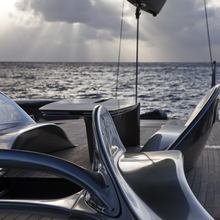
Black Sails Awards & Nominations
- The World Superyacht Awards 2011 Best Refitted Yacht Winner
- International Superyacht Society Awards 2011 Best Refit Winner
NOTE to U.S. Customs & Border Protection
Specification
S/Y Black Sails
SIMILAR LUXURY YACHTS FOR CHARTER
Here are a selection of superyachts which are similar to Black Sails yacht which are believed to be available for charter. To view all similar luxury charter yachts click on the button below.
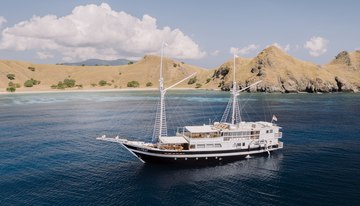
40m | Konjo Boat builders
from $55,300 p/week
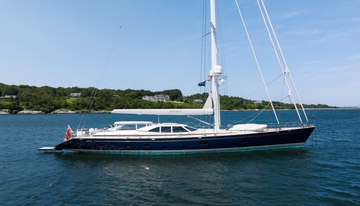
37m | Fitzroy
from $91,000 p/week
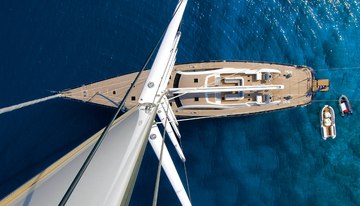
Aristarchos
40m | Nautor's Swan
from $81,000 p/week ♦︎
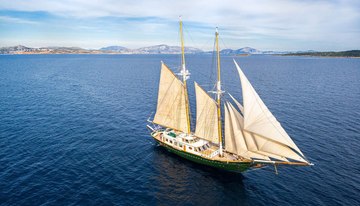
35m | Basimakopouloi
from $41,000 p/week ♦︎
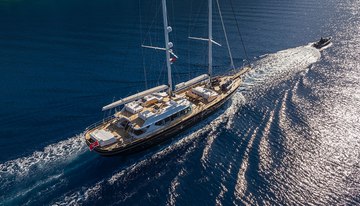
40m | Costruzioni Navali Tigullio
from $92,000 p/week ♦︎
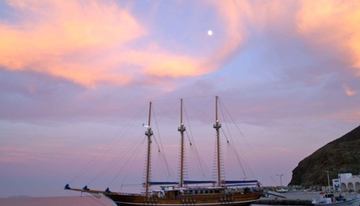
BAHRIYELI D
42m | Custom
from $16,000 p/week ♦︎
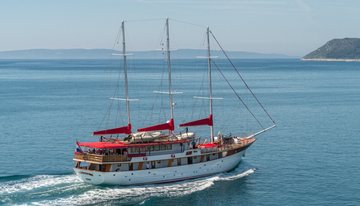
41m | Custom
from $36,000 p/week ♦︎
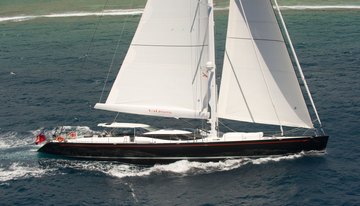
37m | Yachting Developments
from $79,000 p/week ♦︎
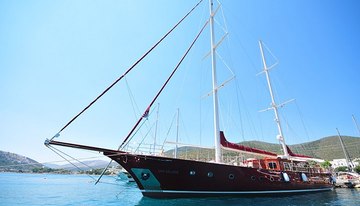
Casa Dell Arte II
39m | ADA Yacht Works
from $38,000 p/week ♦︎
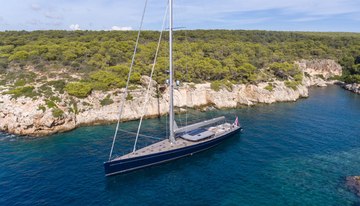
39m | Vitters
from $85,000 p/week
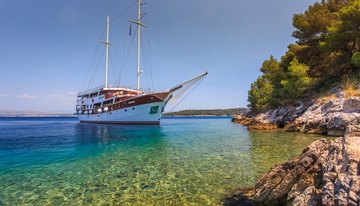
from $27,000 p/week ♦︎
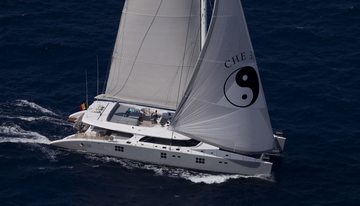
35m | Sunreef Yachts
As Featured In
The YachtCharterFleet Difference
YachtCharterFleet makes it easy to find the yacht charter vacation that is right for you. We combine thousands of yacht listings with local destination information, sample itineraries and experiences to deliver the world's most comprehensive yacht charter website.
San Francisco
- Like us on Facebook
- Follow us on Twitter
- Follow us on Instagram
- Find us on LinkedIn
- Add My Yacht
- Affiliates & Partners
Popular Destinations & Events
- St Tropez Yacht Charter
- Monaco Yacht Charter
- St Barts Yacht Charter
- Greece Yacht Charter
- Mykonos Yacht Charter
- Caribbean Yacht Charter
Featured Charter Yachts
- Maltese Falcon Yacht Charter
- Wheels Yacht Charter
- Victorious Yacht Charter
- Andrea Yacht Charter
- Titania Yacht Charter
- Ahpo Yacht Charter
Receive our latest offers, trends and stories direct to your inbox.
Please enter a valid e-mail.
Thanks for subscribing.
Search for Yachts, Destinations, Events, News... everything related to Luxury Yachts for Charter.
Yachts in your shortlist
Black Sails: 13 Facts About The Starz Hit Worth More Than Stolen Treasure

With contemporary series like "Vikings" and "Game of Thrones," "Black Sails" may often be overlooked when compared to other epic dramas of the 2010s, which makes it one of the most underrated shows of the decade. Not only is the scale of the pirate adventure immense with many scenes taking place upon impressive naval vessels, but the political intrigue and intimate interactions of the characters make it an entertaining watch for several different audiences.
The show as a whole does a brilliant job of mixing fiction with historical figures like the notorious pirate captains Blackbeard (Ray Stevenson) and Charles Vane (Zach McGowan) whose lives were so legendary that they verge on fantasy. But at its core, the story centers on the complicated friendship between its two main characters, Captain Flint ( Toby Stephens ) and his deviously clever quartermaster, Long John Silver, in the years before their sagas are continued in the later tale of "Treasure Island." For a series devoted to such larger-than-life individuals, the making of it also had its fair share of epic details and moments as well, which you can enjoy reading below.
The series is an unofficial prequel to Treasure Island
Although "Black Sails" is its own story for the most part, from the very beginning it was always meant to show the events building up to the classic work of fiction "Treasure Island" by Robert Louis Stevenson. More than anything, the creators of the series wanted to tie up loose ends to the famous tale and give their explanation to who the characters were up to in the years before, as showrunner Jonathan Steinberg explained to Entertainment Weekly : "At the end of the book, it's recounted by other people that Captain Flint died in Savannah alone, which begs a lot of questions."
Flint's origin is certainly not the only one covered with both Long John Silver's and Billy Bones' backstories explained thoroughly as well. For Billy especially, his situation in the finale of the series gives all new meaning to what happens to him later in the novel. Steinberg added: "It is clear we are suggesting he is on 'Treasure Island,' which I think has a number of implications if you go back and read the book."
After four seasons, it is clear the showrunner was pleased with how the series handled the continuity, saying: "It felt like we had finished the argument a little bit, in terms of connecting it not just to 'Treasure Island,' but to our contemporary understanding of what piracy was, about what Caribbean piracy was."
The opening credits features the hurdy-gurdy
Several aspects of "Black Sails" make it stand out as a particularly fascinating TV series, with one of the top being its unique theme music in the opening credits. Not only is the memorable tune composed by the talented Bear McCreary who is well known for his work on "The Walking Dead" and "Battlestar Galactica," but it also features quite an unusual instrument known as a hurdy-gurdy, according to Entertainment Weekly .
Also known as a wheel fiddle, the hurdy-gurdy is a folk instrument that has existed for around 1,000 years and is played to this day all over Western Europe, from Italy to England. In a 2010 TED Talk , musician Caroline Phillips explained that the complex and bulky device originally required two people to operate it until the design was improved a few centuries later, so it could be used by a single performer. Although a fundamental part of the instrument is the strings, akin to a violin, the sound produced can also be compared to bagpipes.
The show was filmed in South Africa
While "Black Sails" takes place predominantly in the Caribbean, that was not the place chosen to film the epic pirate drama. Instead, the Starz network went with the fairly new Cape Town Studios for the production, and needless to say that the South African-based company was ecstatic over the decision. Ahead of filming Season 1, Film Afrika producer Vlokkie Gordon said: "We are delighted to have been awarded ['Black Sails'] and it is further proof of South Africa's international reputation for outstanding production skill and expertise" (via The Location Guide ). Gordon continued: "A production of this scope provides not only employment for South Africans, but also skills transfer which is in line with Film Afrika's policy of supporting growth and development of the South African film and television industry."
The swashbuckling series was then added to the growing list of productions shot out of Cape Town, including "Safe House," "Chronicle," and "Mad Max: Fury Road," as per the Cape Town Film Studios website. Plus, another Starz series benefited greatly from the elaborate ship sets built there, with "Outlander" using the Jamaican landscapes in its third season, according to Entertainment Weekly .
300 people worked on the pirate ship
The impressive sailing vessels featured in "Black Sails" are almost as important to the story as the characters themselves. Therefore, a ton of work was put into the construction of the sets in order to make the maritime setting feel real for the cast, and more importantly, the audience. In a behind-the-scenes clip shared by Starz , senior rigger Joel Yates explained: "The carpenters building the boat it took them, I think, four or five months. They want it to look as authentic as possible because what we've built is a very accurate replica of a sailing ship."
The end product, called The Walrus in the show, was massive as well, as Yates revealed that the full ship is approximately 140 feet long. And to pull off such an incredible feat, it took a gigantic crew with various skill sets, as construction coordinator Clive Pollack shared: "There are 300 people working on the boat. There are carpenters, sculptors, painters, riggers, sailmakers."
There were no bathrooms for cast and crew on the ship
For as grand as the prominent pirate ship is in "Black Sails," it does have its faults as it also serves as the set of a modern TV production. In a 2016 interview with Den of Geek , actor Zach McGowan revealed the biggest problem for the cast and crew on set: "The hardest thing about the ships, most people don't realize, is just when you're on the ship at the top of the deck somewhere, it's very far to the nearest bathroom. There's no bathroom on the ships."
Even with that minor complaint, McGowan went on to stress that being on the deck of the ship at sea was such a great experience that the actor wished he had more of those scenes. It's also his opinion that most of the cast felt the same way, except possibly the ones who spent the most time on board, such as Toby Stephens.
The actors went through pirate boot camp
Like most epic dramas featured on premium channels, "Black Sails" is filled with massive battle sequences, in this case often between rival pirate clans, or against the relentless forces of the British and Spanish empires. While the nature of naval warfare means that a good amount of these conflicts are long distance, yet devastating, as cannonballs attempt to rip enemy vessels apart, much of the brutal combat is at close quarters.
All of the fight scenes in the series are quite impressive, so it makes sense that many cast members received special training. In a Q&A with a few of the main actors, shared by Starz in 2015, Luke Arnold revealed: "We all went through a three-week pirate boot camp. Well, the pirates of the crew did at the beginning of shooting." And it was a good thing that they did because when asked if they could survive the rough conditions of the time period, the general consensus was an adamant no. Toby Stephens then elaborated with a laugh: "The real trouble, I'd be ok on Nasau, it was as soon as I'd get on a boat and I had to sail anywhere."
Clara Paget came up with Anne Bonny's distinctive look
From Charles Vane, Edward Teach, and Jack Rackham to Captain Flint, Long John Silver, and Billy Bones, "Black Sails" has all sorts of characters based on either historic people or from the famous fictional tale, "Treasure Island." Therefore, both the writers of the show and the actors who portrayed these popular figures had to work with what was already known about them. But at the same time, there was a lot of creative freedom as well.
A somewhat minor, though fascinating aspect of another one of these real characters in the series, Anne Bonny, was thought up by actress Clara Paget. In a 2016 interview with Den of Geek , when asked what she contributed to the role, the actress replied: "I suppose the hat. That came completely organically. I tried on this hat and then I was pulling it down in an almost jokey way, like an old-school Western. Then it became who she is, hiding behind this hat. It really works for the character because, as I said, it shows this vulnerable side at the same time as being a badass through one side or the other. Like schizophrenic, bipolar."
Zack McGowan broke a stuntman's jaw by accident
A major reason that the fight scenes in "Black Sails" are so good is because of the enthusiasm of the cast and crew when filming, yet there was one time that may have gone a little too far. When a stuntman on set named Daryl was to be hit with the butt of a rifle by Zach McGowan, the dedicated performer showed no fear and encouraged the actor to strike him square in the face. The veteran stuntman figured it was no big deal since the thing was only made of rubber. Since Daryl seemed more than fine with the idea, McGowan went along with the idea.
In a 2017 interview with Rotten Tomatoes , Toby Stephens recalled the disastrous, though somewhat funny result: "Zach, who's brilliant at this kind of thing, whacked him straight in the jaw, as the guy asked, and totally broke his jaw. It looks fantastic, it actually made the cut, and it looked absolutely brilliant. At the end of it, I just remember Daryl going, 'No, it's fine. It's okay, don't worry about it.'" Fortunately, the stuntman was not seriously harmed, so they were able to joke about it a bit.
Zack McGowan climbed the balconies of a building to get rum
"Black Sails" is filled with many incredible exploits of pirate warriors as they battle on the high seas, but a behind-the-scenes achievement by one of the actors was almost as impressive as what was shown on screen. During a break in filming, the cast was having a good time together but needed some rum, so Zach McGowan went to rather extreme lengths to remedy the situation.
In order to gain access to the prized liquor in a room several floors up, the actor literally scaled the side of the building all on his own. When talking with Rotten Tomatoes , cast member Hannah New described the amazing sight, saying: "He did this like Spider-Man kind of thing where he climbed up these balconies ... it's incredible, he does like, God knows how many chin-ups every day. So, he can just chin up these balconies."
After McGowan successfully got the rum and then made the way back down with it in his front pocket, the cast waiting down below were too awestruck to do anything but tensely watch. Fellow actress Jessica Parker Kennedy added: "And none of us videotaped it. I think we were all in such shock, it was so scary, I thought he was going to fall and break his neck and we would have to explain it to our producers the next day."
It took all season to film Luke Arnold's underwater scene
In the fourth season of "Black Sails," Long John Silver nearly perishes in the sea as he struggles to escape his sinking ship. Actor Luke Arnold must have been pleased that his character ultimately survived the harrowing experience, but filming the scenes was definitely not easy for the actor. Even though he was confident in the comprehensive training he received beforehand, Arnold still had to overcome a major fear of performing in those conditions.
When asked specifically about those tense underwater moments, he told Collider in a 2017 interview: "That was the beginning of hell that kept getting crazier as it went along. That took all season to shoot. We were in the water tank, from the beginning of the season, stuck underwater, all day." To his dismay, Arnold was right when he assumed it would take longer to finish than the filmmakers first thought, yet it was all worth it, as he added: "Right until the last couple of weeks, I was doing bits of the underwater stuff to make that whole sequence as spectacular as it is."
Luke Arnold received a special gift from a producer
Luke Arnold was one of several major cast members of "Black Sails" who was in the show from the very beginning all the way through to the climactic finale. The actor very much enjoyed his time filming the series, so when he found a cherished memento from the early days, it was a big deal. In the same interview with Collider , he revealed: "We were shooting a scene in Season 4 that was back in Eleanor's office, and I found the piece of paper that I was writing the directions to find the Urca de Lima on, which was the very first scene we shot in Episode 103. Nina Jack, who was one of our producers on Season 4, got it framed and gave it to me as a gift, so I've gone away with that. That was amazing!"
On the other hand, there were parts of the series that Arnold did not remember so fondly, mostly from the difficulties that arose in pretending to have lost a leg. In this endeavor, he was able to use a crutch on screen, but the prop caused him so much discomfort that he grew to despise it.
Luke Arnold had a legless stunt double
Once Long John Silver tragically loses his leg in "Black Sails," Luke Arnold had some difficulty filming scenes as the character, so he was grateful to have help from a stuntman named Ben de Jager who is also missing the limb. The actor told Collider : "It was great to have somebody who's gone through the experience of losing a leg. He did step in for a lot of stuff, mainly because it was so much easier to have him there. If you're shooting from behind or you're focusing on the foot, it's easier to have someone in who's missing the leg than to do it with me and spend a fortune on visual effects to change things."
Though Arnold certainly got along with de Jager, there also seemed to have been a little jealousy in sharing screen time for the role. The actor admitted that a downside for him was his absence in some major Long John Silver moments of the show.
The writers gradually decided to bring back Flint's lover, Thomas
For as dark as "Black Sails" can be throughout the series, it ended on a fairly happy note as the main character, Captain Flint, is finally reunited with the love of his life, Thomas Hamilton (Rupert Penry-Jones). Both men are sentenced to imprisonment on a plantation, yet all that matters to the pair is that they are together again. Viewers may have been somewhat surprised that Thomas had returned to the show given the fact that he was thought to be dead, but over time the writers decided that was not going to be his fate.
In an interview with The Hollywood Reporter in 2017, Jonathan Steinberg explained: "We had a sense in Season 2 when he died off-screen, that any character who dies off-screen, you're taking the word of the messenger as to whether or not it actually happened. We knew we weren't finished with him. And then at some point in Season 3, we realized it would be reasonably late in the series when he came back, so in Season 4 it felt right."

- Board of Directors
- Immigration
- Virtual Museum
- Member Benefits
- Captains’ Circle
- Online Learning
- Learning With Primary Sources
- Engineering
- Mathematics
- Social Studies
- Professional Development
- Testimonials
- Advisory Council
- Ship History Radio
- SHIPS – Immigration
- SHIPS – Transport
- SHIPS – Trade
- Contribute to PowerShips
- Search for: Search Button
Black Sailors in the Age of Sail
SOCIAL STUDIES – Students will learn about the history of black sailors in America and can be assessed using the short answer questions at the end of this lesson.
Share to Google Classroom
Did you know that one out of every five American seamen in the early 19th century was black? At the time, seafaring was the nation’s most common male occupation after farming.
Did you know that Frederick Douglass escaped slavery in disguise as a sailor? Or that the first six autobiographies that black people wrote in the English language were written by seamen?
What about the triggering point of the American Revolution – the Boston Massacre? Did you know that Crispus Attucks, the first man killed at the Boston Massacre was a black seaman? He was a sailor and rope-maker of mixed African American and American Indian descent.

When we learn about the slave trade, we tend to think of the Middle Passage and the sheer horror of men, women, and children stolen from their lands, with a sizable portion not surviving the journey to America. While it’s hard to get precise figures, estimates suggest that 10-20% of people died before reaching America. It’s a sad story that has left many to believe that black people have a fear of ships and the sea. But long before the horrors of the Middle Passage, Africans had strong connections to the sea and vessels, regarding ships and boats as workplaces but a site of spiritual power. Historian W. Jeffrey Bolster said, “I would hope some black kid learning this story would realize he can do anything — because that’s what his ancestors had to do and did.”
“Everybody assumes that any black sailors there might have been at that time would be unlettered and ignorant.” Bolster explained. “And uncovering even one letter by an American black during the 1700s is a big deal. Here we have 12.”

In American Patriots: The Story of Blacks in the Military from the Revolution to Desert Storm , Gail Buckley documents the amazing story of James Forten. Born free in Philadelphia in 1766, James Forten joined the crew of Royal Louis in 1781.
On Forten’s second cruise, a British frigate overran the ship and captured the entire crew. The British captain’s son befriended Forten, and the captain eventually offered him a life in England. However, Forten refused to renounce his American allegiance. He was imprisoned on board the British Old Jersey . Confined with hundreds of prisoners off the coast of New York, Forten struggled to survive (11,000 prisoners died on this ship throughout the war) while continuing to resist the British. After seven months, Forten was released and made the 100-mile trek back to Philadelphia despite severe malnutrition.
After the war, Forten worked for a sailmaker and became the owner of a sail loft. He invented a sail-maneuvering tool and amassed a $100,000 fortune. He was a strong abolitionist and a founding member of the American Anti-Slavery Society. Forten’s relatives and descendants continued his abolitionist and patriotic fights after his death in 1842. His nephew, James Forten Dunbar, served in the Navy during the Civil War .
At the time, sailors were not identified by race. Each person was listed by name, place of birth, residence, age, height, hair type, and complexion. Sailors with “black,” “African,” “mulatto” or “yellow” complexion were almost always described as having “woolly” hair. It is the most reliable indicator of race. When sailors’ complexions were described as “brown” or “dark,” it became complicated since deeply suntanned white sailors could also be described this way. In the absence of other corroborating evidence, Bolster counted these men as white.
Because of the collective hardships of shipboard life, racial stratification was not as pervasive. Of course, some white sailors did treat their black counterparts badly, but far more appear to have accepted their crewmates no matter their race. Sailing was an environment in which mastery of nautical skills was the preliminary factor judging men.
A small percentage of enslaved men became coastal captains or pilots. These men led all black crews, developed tangible skills and leadership abilities. While these men and their ships could only operate in slave territory, these captains created a degree of physical and psychological freedom that was unheard of on land.

Moses Grandy was born into slavery in Camden County in 1786 and as a child became very interested in maritime occupations. As a result of his skills as a river ferryman, canal boatman, schooner deck man, and lighter captain he became known as Captain Grandy. William Grandy, a prominent slave owner in Camden County was Moses’s first slave master. William’s son, James, inherited Moses in 1794 and hired him out annually to various owners to tend ferry along the Pasquotank River and haul lumber in the Dismal Swamp. He was able to purchase his freedom for $600. Captain Grandy dictated his autobiography, “Narrative of the Life of Moses Grandy, Late a Slave in the United States of America,” to fellow abolitionist George Thompson, and it was published in 1843.
Thousands of black patriots served on American vessels during the American Revolution (1775-1783). According to a U.S. Army report on the African American military experience, higher percentages of black men served in the naval forces than the land forces. The Continental Navy did not restrict their service like the army and militias. The navy also protected them from man-stealers and slave masters. But the Continental Navy was relatively small, and black sailors served in even greater numbers on board state naval vessels and privateers.
At the time, many black sailors were enslaved, and records of their service are hard to find. Often owners put forth their slaves to serve under a substitution system, but the owners received their pay. For many black seamen, the most significant development in the American Revolution was the end of slavery in many northern states. After the Revolution, black men in the North could enter the maritime labor market as free men, giving hope to the still enslaved mariners from the South that a society without slavery in the United States could exist.

Within the maritime slave system, captains and pilots like Moses Grandy now had skills that could help propel them toward freedom. By the first quarter of the nineteenth century, many free men of color worked in international seafaring throughout the Atlantic.
Because of stereotyping at the time, however, most mariners of color filled roles as cooks, officers’ servants, or musicians, differentiating them from seamen proper. In 1810, 51% of African American mariners were listed as cooks or stewards in Providence, Rhode Island. Superior officers assigned berths according to race, with white colonial culture mirroring its values on board ships.
While it was difficult for free blacks to acquire land and they faced discrimination in most trades, black New Englanders turned to the sea to keep their families together, acquire land, and gain respectability.
Black seamen became bearers of news from all corners of the world, becoming themselves what newspapers and the royal mail service were to white elites. Whereas white seamen were among the most marginalized in white society, black seamen gained access to privileges, worldliness, and wealth denied to most slaves. Black sailors exemplified black manhood and independence.
As early as 1822, lawmakers began requiring black sailors’ incarceration during southern port calls. Denmark Vesey’s slave revolt in 1822 in Charleston triggered new laws, specifically at black seamen. Vesey, who was a mariner in his youth, never confessed, but several of his leaders did. They pointed to black seamen as the links in the chain of rebellion. Black sailors were eventually banned from Southern ports on the eve of the Civil War (1861-1865). Although there is widespread debate among historians who assert that the Vesey conspiracy was never real, but instead a result of slaveholder paranoia. Vesey’s refusal to “name names” has long been held up as a form of resistance, but others argue he simply had no information to confess as the plot was unreal. Either way, his case led to increased restrictions on black sailors at the time.
After emancipation, blacks shipped out almost exclusively as cooks, Bolster says, in part because of the “wickedly racist” seamen’s unions that gradually took over the maritime trades. By the middle of the nineteenth century, black men had fewer opportunities at sea and racial segregation became more prominent than it was in the past.

Short Answer Questions:
- Name a surprising fact you learned while reading this lesson.
- Why do you think black sailors, slaves or freemen, had greater freedom than on land?
- How did colonial culture mirror life on board a ship for people of color?
- Did freedom of movement in the maritime trades remain consistent for black people over time? Why or why not? Give examples.
Additional Primary Sources
Read Captain Moses Grandy’s autobiography for free from the University of North Carolina at Chapel Hill’s Documenting the American South: https://docsouth.unc.edu/fpn/grandy/grandy.html
Learn more about African American service in the U.S. Navy and read oral histories.
The Civil War Soldiers and Sailors System currently contains the records of approximately 18,000 African American sailors.
Additional Resources
Check out our other lessons on Black history! Learn about the Black Star Line and the fight to desegregate the SS Columbia .
W. Jeffrey Bolster, Black Jacks: African American Seamen in the Age of Sail (Cambridge, Harvard University Press: 1997).
Learn about black sailors serving on the USS Constitution during the War of 1812.
“ Black Men in Navy Blue During the Civil War ,” by Joseph P. Reidy, National Archives.

This work is licensed under a Creative Commons Attribution-NonCommercial 4.0 International License .
Share this:
- Click to share on Twitter (Opens in new window)
- Click to share on Facebook (Opens in new window)
- Click to share on Pinterest (Opens in new window)
- Click to share on LinkedIn (Opens in new window)
- Click to email a link to a friend (Opens in new window)

- Rent or buy
- Categories Categories
- Getting Started

Black Sails
- Store Filled Season 1
- Store Filled Season 2
- Store Filled Season 3
- Store Filled Season 4
- Episode number
- Newest episodes
- Available to watch

Customers also watched

Cast and Crew

Other formats
3132 global ratings
How are ratings calculated? Toggle Expand Toggle Expand
- Amazon Newsletter
- About Amazon
- Accessibility
- Sustainability
- Press Center
- Investor Relations
- Amazon Devices
- Amazon Science
- Start Selling with Amazon
- Sell apps on Amazon
- Supply to Amazon
- Protect & Build Your Brand
- Become an Affiliate
- Become a Delivery Driver
- Start a Package Delivery Business
- Advertise Your Products
- Self-Publish with Us
- Host an Amazon Hub
- › See More Ways to Make Money
- Amazon Visa
- Amazon Store Card
- Amazon Secured Card
- Amazon Business Card
- Shop with Points
- Credit Card Marketplace
- Reload Your Balance
- Amazon Currency Converter
- Your Account
- Your Orders
- Shipping Rates & Policies
- Amazon Prime
- Returns & Replacements
- Manage Your Content and Devices
- Recalls and Product Safety Alerts
- Conditions of Use
- Privacy Notice
- Consumer Health Data Privacy Disclosure
- Your Ads Privacy Choices

Black Sails (2014)

Streaming in:
We checked for updates on 249 streaming services on April 10, 2024 at 7:31:13 AM. Something wrong? Let us know!
Black Sails - watch online: streaming, buy or rent
Currently you are able to watch "Black Sails" streaming on Starz Apple TV Channel, Starz Roku Premium Channel, Starz, Spectrum On Demand, Starz Amazon Channel or for free with ads on The Roku Channel. It is also possible to buy "Black Sails" as download on Amazon Video, Apple TV, Vudu, Microsoft Store, Google Play Movies.
Newest Episodes
S4 e10 - xxxviii, s4 e9 - xxxvii, s4 e8 - xxxvi, where does black sails rank today the justwatch daily streaming charts are calculated by user activity within the last 24 hours. this includes clicking on a streaming offer, adding a title to a watchlist, and marking a title as 'seen'. this includes data from ~1.3 million movie & tv show fans per day..
Streaming charts last updated: 9:13:16 AM, 04/10/2024
Black Sails is 207 on the JustWatch Daily Streaming Charts today. The TV show has moved up the charts by 50 places since yesterday. In the United States, it is currently more popular than The Good Wife but less popular than The Resident.
The pirate adventures of Captain Flint and his men twenty years prior to Robert Louis Stevenson’s classic “Treasure Island.” Flint, the most brilliant and most feared pirate captain of his day, takes on a fast-talking young addition to his crew who goes by the name John Silver. Threatened with extinction on all sides, they fight for the survival of New Providence Island, the most notorious criminal haven of its day – a debauched paradise teeming with pirates, prostitutes, thieves and fortune seekers, a place defined by both its enlightened ideals and its stunning brutality.
Videos: Trailers, Teasers, Featurettes

Streaming Charts The JustWatch Daily Streaming Charts are calculated by user activity within the last 24 hours. This includes clicking on a streaming offer, adding a title to a watchlist, and marking a title as 'seen'. This includes data from ~1.3 million movie & TV show fans per day.
Production country
People who liked black sails also liked.

Popular TV shows coming soon

Upcoming Drama TV shows

Similar TV shows you can watch for free

- Edit source
- View history

All items (76)

- Category:Destroyed Ships

- English Slaver

- Category:Historical Ships

- Category:Merchant Ships

- Category:Pirate Ships

- Category:Royal Navy Ships

- Template:Ship

- Category:Woodes Rogers' First Fleet

- Category:Woodes Rogers' Second Fleet


Welcome to Black Sails.
San diego's first sailing club for people of color.

IMAGES
COMMENTS
The black color has become strongly associated with performance sails. It's kind of like the marker of a quality sail. Yacht owners and even regular boat enthusiasts know that a black sail is the standard of top performance because it's made from premium materials. That said, changing the color might distance the product from that image.
Others simply add a non-woven layer of colored polyester material to make the sails black. North Sails 3D molded downwind racing sails are grayer and more translucent, especially when the sun is behind the sail. These sails come with our Helix load shearing technology luff structure. The 3Di molded downwind sails use. North Sails Expert Per ...
Additionally, black sails reduce the amount of glare coming off of the sails, making it easier for the crew to navigate and sail the yacht. The black color of the sail also has a psychological impact on the crew. Black sails look sleek and sophisticated, and can give the crew a feeling of confidence and power.
The use of black sails is most effective in colder climates where the air is denser and less efficient at powering the sail. Additionally, black sails are more durable and resistant to UV rays, which can cause damage to the sail over time. This makes black sails a practical choice for racing yachts that are exposed to the sun and wind for ...
It had taken them three years and $12 million to develop the technology which would later dominate sailboat racing. The original sails were almost transparent like Russ's sail, but North's eventually changed the color to dark grey. Ten years later, North introduced the 3Di sails in matt black, and most other manufacturers followed the trend.
Many yachts sails are now made from carbon, which leads to better performance. Carbon is black, and therefore the yacht sails are black.
Black Sails is an American historical adventure television series set on New Providence Island and written to be a prequel to Robert Louis Stevenson's 1883 novel Treasure Island. The series was created by Jonathan E. Steinberg and Robert Levine for Starz.It debuted online for free on YouTube and other various streaming platform and video-on-demand services on January 18, 2014.
Black Sails: Created by Robert Levine, Jonathan E. Steinberg. With Toby Stephens, Luke Arnold, Toby Schmitz, Hannah New. Follows Captain Flint and his pirates twenty years prior to Robert Louis Stevenson's classic novel "Treasure Island."
Buy Black Sails on Vudu, Prime Video, Apple TV. Seasons Season 1 65% 2014 Details Season 2 100% 2015 Details Season 3 2016 Details Season 4 80% 2017 Details
Black Sails opens promisingly enough with a sea battle, followed by threats of violent upheaval aboard the Walrus, captained by the arrogant, aloof Flint (Toby Stephens). Too soon, though, the action moves onto land. And while Starz staples like graphic sex and savagery are hardly uncommon occurrences in the bustling debauchery of New ...
Instantly recognisable with her black sails and Dynarig set-up, Black Pearl is the second-largest sailing yacht in the world. Delivered during the same year as 142.81-metre Sailing Yacht A (officially designated as a sail-assisted motor yacht), Black Pearl spent five years in development at Dutch yard Oceanco. Dykstra Naval Architects, Ken Freivokh, Nuvolari Lenard, BMT Nigel Gee and Gerard P ...
Black Sails (TV Series 2014-2017) cast and crew credits, including actors, actresses, directors, writers and more. Menu. ... Boat Captain 2 episodes, 2015 Martin Van Geems ... Larson 2 episodes, 2015 Scott George ... Spanish Advisor 2 episodes, 2017 ...
Through a swash-buckling four-season run, fans of "Black Sails" have said ahoy to plenty of drama and fights on the open waters. First airing on Starz in 2014, the show follows a group of pirates ...
S1.E5 ∙ V. Sat, Feb 22, 2014. Flint and his crew of the Walrus play a deadly game of naval warfare when they engage Captain Bryson and the Andromache on the open sea to gain precious cargo. Meanwhile, Richard forces his daughter's hand about his business when he makes an announcement to the locals about his assets being liquidated, causing a ...
Sleeps 10 overnight. The multi-award winning 39m/127'11" sail yacht 'Black Sails' (ex. Cannonball) was built by Wally in Italy at their Fano shipyard. Her interior is styled by Italian designer design house Wally and she was completed in 2009. This luxury vessel's exterior design is the work of Javier Soto Acebal and she was last refitted in 2010.
Black Sails was a story about Captain Flint (Toby Stephens) and "Long" John Silver (Luke Arnold). After four seasons of an unlikely partnership-turned-friendship, the two men were at odds once ...
The series is an unofficial prequel to Treasure Island. Starz. Although "Black Sails" is its own story for the most part, from the very beginning it was always meant to show the events building up ...
After the war, Forten worked for a sailmaker and became the owner of a sail loft. He invented a sail-maneuvering tool and amassed a $100,000 fortune. He was a strong abolitionist and a founding member of the American Anti-Slavery Society. Forten's relatives and descendants continued his abolitionist and patriotic fights after his death in 1842.
Black Sails. Season 1. Hundreds of British soldiers lie dead in a forest… the Royal Navy sails back to England… the West Indies are now a war zone, and the shores of New Providence Island have never been bloodier. With the help of Eleanor Guthrie, Woodes Rogers transforms Nassau into a fortress, as Captain Flint amasses a fleet of ...
Black Sails - watch online: streaming, buy or rent. Currently you are able to watch "Black Sails" streaming on Starz Apple TV Channel, Starz Roku Premium Channel, Starz, Spectrum On Demand, Starz Amazon Channel or for free with ads on The Roku Channel. It is also possible to buy "Black Sails" as download on Amazon Video, Apple TV, Vudu ...
Category page. This category is for all ships that appear in Black Sails. A. Andromache. B. Black Hind. Blackbeard's ship. Brig. Brigantine.
S1 E8 - VIII. March 14, 2014. 57min. TV-MA. The hunt for the Urca is on. Everything changes for Eleanor. Bonny and Rackham's sins come back to haunt them. Black Sails, centers on the tales of Captain Flint and his notorious crew fighting for the survival of New Providence Island.
Black Sails was formed in 2010 by black sailors. from the Southern California area. We are working towards becoming a non-profit organization dedicated to promoting the sport of sailing. Eventually we would like to bring the sport into neighborhood schools as a outlet for students. We meet and sail monthly at one of the various harbors in the ...